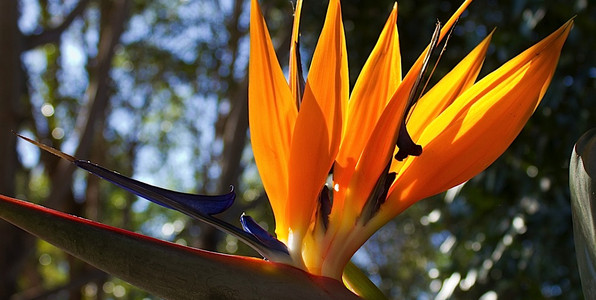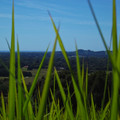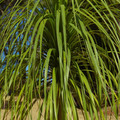Gallery
Click the thumbnails below to view image gallery:Palms provide natural canopy and beauty to any garden or landscape. Their soft appearance makes any garden atmosphere cool and relaxing, much like a tropical paradise.
Like most other plants, palms take a while to grow. But if you cannot wait for your tropical paradise to arise, there are fast growing varieties
Bangalow Palm (Archontophoenix cunninghamiana)
Endemic to the central eastern coast of Australia, the Bangalow Palm thrives in this rainforest region. Growing at an average of almost a metre per year, this palm can reach a height of 25 metres. Its physical features resemble that of another variety of the genus Archontophoenix, the Alexandra Palm.
Also known as King Palm, it produces violet-coloured flowers, which develop into red fruits. The fruits attract birds and when planted in your garden, you can expect frequent visits from different species.
Due to the nature of their habitat, Bangalow Palms love the sun but in combination with a steady supply of water. They can also thrive in a shadier environment. Add a good fertilizer to aid in the development of robust growth and a sturdy trunk.
Cocos Palm/Queen Palm(Syagrus romanzoffiana)
Thriving on the Australian east coast, the Cocos Palm is easy to identify with its cluster of golden yellow flowers that dangle from the center of its fronds.
Cocos Palms can survive in a variety of different conditions, which make them one of the fastest and easiest to grow. These are both cold tolerant and thrive in tropical to sub-tropical environments. Also known by their other name, Queen Palm, this variety has pinnate leaves that extend upward.
The average annual growth rate is 1 to 2 metres. In less than 5 years, the Cocos Palm can reach a height of 10 metres.
Foxtail Palm (Wodyetia bifurgata)
The Foxtail Palm can be found in the remote areas of Queensland, Australia. Less than 30 years since its first discovery, this palm variety found its way to the rest of the world through smugglers who were in awe of its leaves.
This palm is one of the easiest to grow because it can thrive in many different conditions. However, it requires a good water drainage system so the trunk and roots do not rot, killing the plant. It can tolerate soil that contains a relative amount of salt that other palms will not grow in.
A definite fast-grower, the Foxtail Palm has developed a self-cleaning system that sheds fronds when they have reached their life expectancy. It grows to about 10 metres and produces large orange-coloured fruits upon maturity.
Majestic Palm (Ravenea rivularis)
Although they display a rather unruly cluster of fronds, Majestic Palms are growing in popularity especially in the Queensland area. These are endemic to Madagascar and respond well to plenty of water in well-drained soil.
The Majestic Palm also loves basking under the sun's rays. A regular dose of Epsom Salts will also help this palm develop greener leaves. The Magnesium content in the Epsom Salts helps replenish this palm's supply as it is unable to produce its own. Sprinkling of the salt on its roots once every two weeks is enough.
Despite being a sun-lover, the Majestic Palm can also grow in an area that receives minimal to poor lighting. Reaching a height of about 12 metres the Majestic Palm can stand firm and proud in any garden area.
The Traveller's palm or East West Palm (Ravenala madagascariensis)
Is not a true palm, is also fast growing with large tropical banana looking leaves. Its downside is that it retains its dead leaves.
The way that its fronds are arranged make this plant a perfect garden backdrop or as a landmark for your house. When fully grown, the Triangle Palm's size can be formidable but will definitely make your garden look like a tropical paradise.
The species comes from Madagascar and its genus is often classified together with the banana family( member of Bird of Paradise family). The stem of its fronds are shaped as such that it is able to hold water. Inherently, this was the palm's means of survival during dry spells or in warm areas. But it also served another purpose by providing water for thirsty travelers who cut the stems to get to the liquid. This is where the palm got its name.
As it grows, frond bases cover the bottom part of the palm but fall off gradually to expose a sturdy trunk beneath. The Traveller Palm loves the sun and naturally follows its path. The fan-like arrangement of its fronds spread in an east-west direction. Take this information into account if you plan to add this to your tropical garden.
The Nicholai (Strelitiza nicholai) is not from the palm family but complements them. It has large tropical leaves and grows to about 10 metres. It is named because of the characteristic large bird like flowers. It is fast growing and does well in subtropical and cold climates.
The Strelitizia regia is much smaller than the Nicholai and also clumps and has beautiful flowers.
<< Previous Palms that will grow in Melbourne, South Australia and Victoria | Back to Mullumbimby Palm Blog | Next >> Palms: Solving Brown Tips and Leaf Problems












